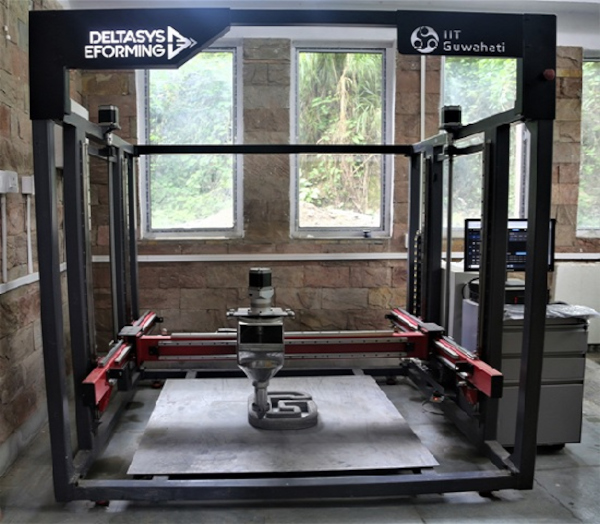Concrete 3D printing is gaining momentum in the building and construction industries. Recent developments in this field such as 3D printed modular houses, pedestrian footbridges, office buildings, public schools, low-cost toilet units have the potential to set off a paradigm change in the practice of construction.
Indian Institute of Technology (IIT), Guwahati researchers have developed 3D printed urban furniture using construction material made from local industrial wastes. Traditionally, these structures were mold cast which requires more concrete material, labour, and formwork preparation. However, with 3D concrete printing, optimized designs are printed with 75 percent less concrete and without the need for mold.
Researchers from the Sustainable resources for Additive Manufacturing (SReAM) at IIT Guwahati utilized new cementitious mix compositions, amenable for 3D printing. The concrete printer jointly developed by IIT Guwahati and DELTASYS E FORMING is capable of printing components up to 1m long, 1m wide and 1m tall. The complete cycle for 3D-printed urban furniture took about 20 minutes to complete.
The IIT Guwahati research group used specially developed printable concrete containing industrial wastes as binders to build 3D printed furniture with a seating height of 0.4 m, a width of 0.4 m, and arch-shaped support that was modelled and sliced using SolidWorks and Simplify3D, respectively. The entire unit was printed layer by layer at an 80 mm/s speed, with each layer having a 10 mm height. After the unit was printed, it was covered by moist gunny bags for 7 days to cure before being used.
Concrete 3D printing is gaining momentum in the building and construction industries. Recent developments in this field such as 3D printed modular houses, pedestrian footbridges, office buildings, public schools, low-cost toilet units have the potential to set off a paradigm change in the practice of construction.
Speaking about this Research, Dr Biranchi Panda, Department of Mechanical Engineering IIT Guwahati, said, “We showcased how material-efficient structures can be produced in our lab scale 3D printer. Our goal is to design high performance concrete mixes made from industrial wastes for printing such complex structures.”
The team is now exploring underwater concrete printing and the possibility of printing functional reinforced concrete using low carbon materials. Developments related to process automation, advanced print head design are the ongoing project in the PI team, funded by the Department of Science and Technology (DST), India, the IIT Guwahati statement said.
Highlighting the unique aspects of this research, Prof. T.G. Sitharam, Director, IIT Guwahati said, “3D printing of concrete can be a technological solution for reducing carbon footprint in building and construction industry. From an Indian context, techno-economic analysis must be carried out that not only the environmental sustainability but also aspects relating to cost, take into account quality, labor, and maintenance associated with 3D printing.”
The research team believes that the on-demand, on-site 3D concrete printing will have a global impact on versatile construction applications and multi-billion-dollar market worldwide. The future jobs will be marshalled into design, automation, servicing, and maintenance of digital systems.
You may also like
-
New Heat-Based Approach To Cancer Treatment Can Reduce Chemotherapy Doses
-
Scientists Take A Major Step Towards Unification Of Classical & Quantum Gravity
-
India Graphene Engineering and Innovation Centre (IGEIC) Under the Vision of Viksit Bharat@2047 Launched
-
New High-Performance Gas Sensor can Monitor Low Level Nitrogen Oxides Pollution
-
Antidepressant Drug can be Repurposed for Treating Breast Cancer
